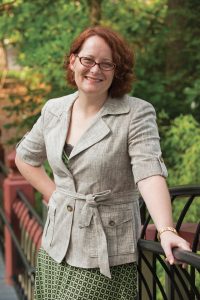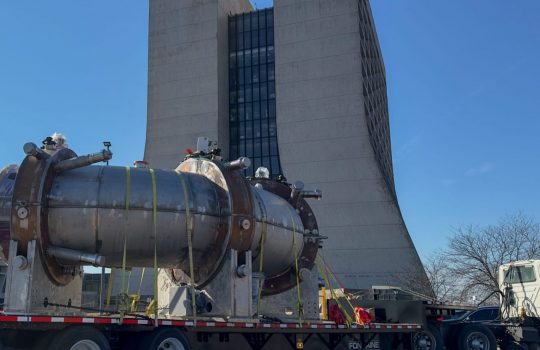Fermilab’s largest operating neutrino experiment gains a new leader as it prepares to search for new physics that could reshape our understanding of the universe.
Tricia Vahle, Mansfield associate professor of physics at William & Mary and longtime leader and scientist on Fermilab’s NOvA neutrino experiment, was recently elected as its new co-spokesperson. She assumed her role on March 21.
Vahle joined NOvA in 2008, when it was still in its infancy — designed, but not yet built. She was instrumental in the experiment’s early years as one of the founders of a NOvA data analysis group. Later she became its analysis coordinator, overseeing teams focused on using the experiment’s data to investigate different physics phenomena.
Now, as NOvA co-spokesperson, she will lead the experiment alongside Fermilab scientist Peter Shanahan, who played a major role in completing NOvA’s construction on time and under budget and taking it into its data collection and analysis phase.
“Tricia has a huge amount of experience on NOvA, and with neutrino physics in general,” Shanahan said. “She’s been working on NOvA for many years and has a good sense of both organizational and scientific aspects of leading such an experiment.”
Vahle succeeds former co-spokesperson Mark Messier of Indiana University. Shanahan and Vahle say the collaboration is grateful to Messier for his 12 years of outstanding service to the experiment, from its design to its first scientific results, bringing the experiment to where it is today.
“Tricia is taking the helm at a really exciting time for the experiment. We’re just starting to push the experiment to answer the scientific questions it was meant to answer,” Messier said. “NOvA is moving forward into the next era of science.”
The NOvA experiment, which started up in 2014, aims to study the shape-shifting behavior of neutrinos, which are mysterious subatomic particles that could help us better understand how our universe evolved. They come in three types, and as they travel, they shift from one type into another according to so-called oscillation patterns.
To get a better handle on how they oscillate, scientists study how neutrinos change over long distances: Fermilab’s powerful particle accelerators send a beam of neutrinos 500 miles from the lab (just outside Chicago, Illinois) straight through Earth to a giant neutrino detector in Ash River, Minnesota. Scientists compare the measurements made at Fermilab to those in Minnesota.
After four years of taking data on neutrinos, NOvA recently shifted to recording data on their antimatter counterparts, antineutrinos. Differences in the oscillations of the two particles could solve the mystery of why there is an asymmetry between matter and antimatter in our universe. They could also reveal new physics.
“It’s a very exciting time because we’re on the verge of realizing NOvA’s full physics potential,” Vahle said. “We’re looking forward to using more sensitive data analyses to study both antineutrinos and neutrinos and compare them.”
NOvA, which is made up of almost 250 scientists from 48 institutions around the world, will continue to run until at least 2024, switching between antineutrino and neutrino measurements to obtain roughly equal amounts of data for each. NOvA will also focus on making ever more precise measurements of neutrinos’ basic properties, such as the relationship between the masses of the different types.
“My goal in the near future is to work together with Tricia, the collaboration and Fermilab to meet the challenge of furthering our understanding of neutrino physics,” Shanahan said. “Our work ahead will focus on getting the most possible data for NOvA and making the most of it through ongoing improvements to our analysis.”
Vahle says she’s happy to be at the forefront of potential neutrino discovery.
“In the long term, we aim to keep people excited about our experiment and the top-notch physics we are doing,” Vahle said.




